Tillandsia tafiensis
Click thumbnails for full size, scaled to a new window.
formerly Tillandsia xiphioides var. tafiensis now raised to species status.
See Tillandsia xiphioides for discussion of types.
Tillandsia tafiensis
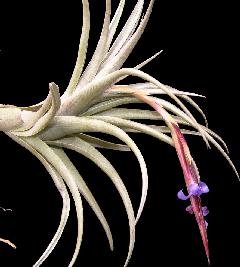
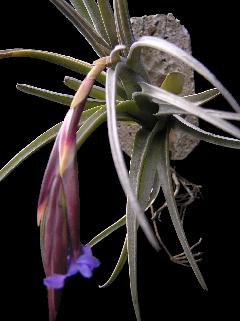
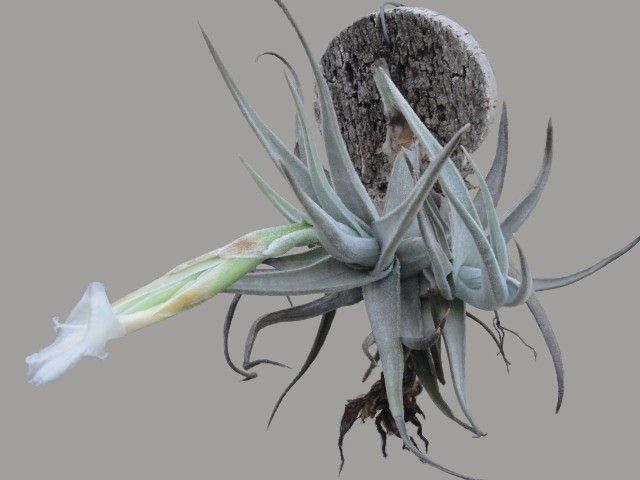
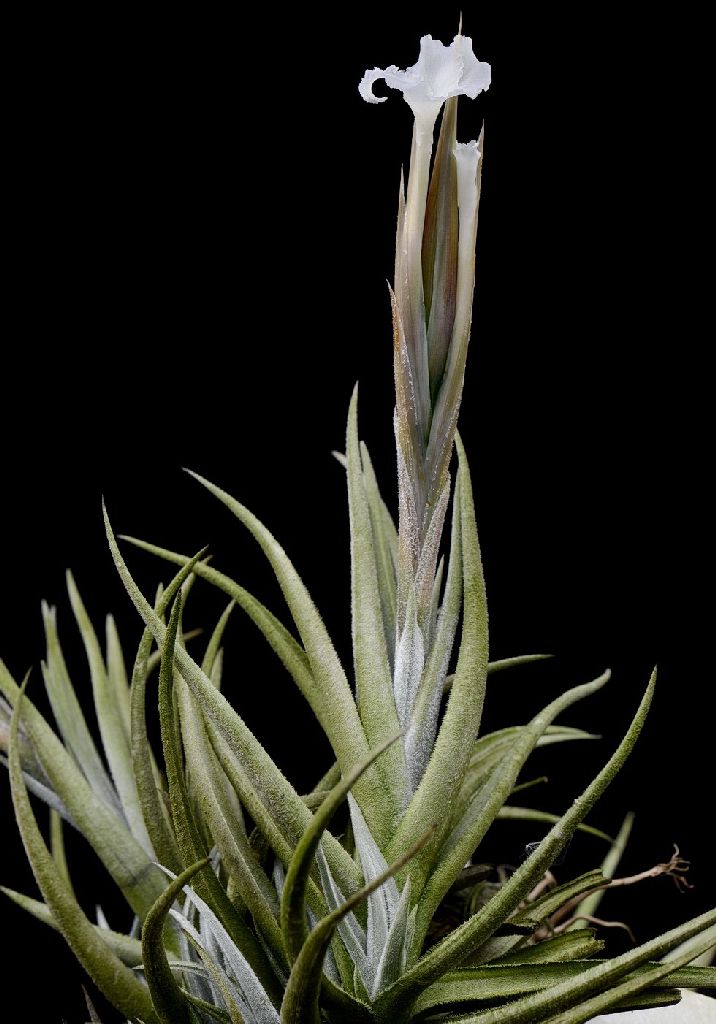
| Ken Woods 06/09. As xiphioides "Blue". (*actually zecheri) |
Stephen Haines 11/13. As xiphioides var. tafiensis |
Peter Tristram 14/11/13. xiphioides sold as tafiensis |
*Chris Larson ... "There is also the chance that Ken Wood's plants are some of Marj McNamara’s T. zecheri variants (& now also related species) that she collected on her numerous trips to NE Argentina - and we know that Ken had many of Marjory's plants. I have a couple of plants from this region, ex-Europe, that are also very close to this.
Stephen Haines' and Peter Tristram's photos are "white T. tafiensis."
The Americans imported the white flowered form of T. xiphioides from the top of the Valle del Tafi, Argentina, as they couldn’t find the blue one, & distributed it as T. xiphioides var tafiensis. (Marj & I found this form there at the top of the valley.) From there it was spread around the world under this name – so everyone had a form with white flowers which doesn’t fit the description of T. tafiensis.
In the mid 90's some Aussie collectors, most prominently Derek Butcher & Len Colgan, imported the blue flowered true T. tafiensis from Europe, which grows just north of the ruins of Quilmes – a matter of miles from the population that the Americans were selling as T. xiphioides var tafiensis.
I did not find this population, but found another form of T. tafiensis (with blue flowers) near Cachi, a few hours north."
Steve Haines 2/11/13 ... "As Peter mentioned it is xiphioides flowering time, I have a few different kinds flowering at the moment, here are some pics.
1st photo; T. xiphioides var tafiensis, large and somewhat translucent white flower that is short lived.
Len Colgan 3/11/13 ... "Thanks for sharing those pictures of forms of T. xiphioides.
I do not know whether or not it is strictly correct to label the first of them as T. xiphioides var tafiensis. The description of this variety stipulates large purple flowers, and I personally only use this name if that is the case. However, in the USA, they do not have the purple flowered form, and use the var tafiensis tag for any very scurfy forms, undoubtedly with white flowers, whether or not they come from anywhere near Tafi in Argentina.
The second form from Germany most probably originated from me. Maurice can confirm if that is the case. It is a smaller form with gun-barrel grey leaves, and was collected by the River Mizque in Bolivia.
What is really interesting about collecting T. xiphioides in Bolivia, rather than in Argentina, is that widely separated habitats yield quite different forms, making it possible to have a varied mini-collection of T. xiphioides types."
Chris Larson 3/11/13 ... "One of the things that Marj Mc & I noted on our trip – my first to Argentina – was that Isley’s tafiensis is very very similar to the form that grows right beside the road just over the ridge out of the Tafi valley – only about 1 or 2 km from the pass (& the only ones we could find at the correct altitude near the Tafi valley) – but still within the state of Tafi. I agree that this is not var tafiensis by the description. The site of the blue flowered var. tafiensis to be found near there (according to Smith & Downs) is some 10 or 15 miles away. Which I never found due to lack of detail on maps at that time – Google maps make life easier for collectors now – but AQIS makes it harder."
Derek Butcher 3/11/13 ... "I can only back Len on this one. As the DVD says -
Tillandsia xiphioides Ker-Gawler var tafiensis L. B. Smith, Phytologia 20: 173. 1970.
Tillandsia friesii sensu Castellanos, An. Mus. Nac. Hist. Nat. Buenos Aires 37: 501, pl. 1. 1933; in part, non Mez, 1906.
Differs from Type in -
Leaf-scales with narrow lobes, making the leaves tomentose-lepidote.
Floral bracts 5-6 cm long. Sepals 30 mm long; Petals violet.
Type. Schreiter 7176 (holotype US, isotypes GH, NY, LIL), Managua (Colalao del Valle), Tafi, Tucuman, Argentina, Dec 1931.
Distribution. Epiphytic, 2000-3000 m alt, northwestern Argentina. Tucuman, Tafi: Quebrada de Amaicha, El Molle, Nov 1932, Schreiter 8835 (GH, LIL).
We have the true blue in Australia and we should not settle for second best. It took me several years to convince Rainforest Flora that they had the wrong name on their plants and there is a possibility this could be the source of wrongly identified stock. Many years ago now in trying to keep up with the latest I did import from Germany only to get white flowers. Luckily the supplier listened to my plea and on the second attempt I got the blue!
So if your 'tafiensis' flowers white please change the label to straight xiphioides. Remember here that 'lutea' only applies if the petals are a yellowish hue."
Peter Tristram 14/11/13 ... "Hi all, another white "tafiensis" from Deutschland, from a Botanic Garden as well! At least the luteas are flava."
Derek Butcher 27/10/15 ... "For those who thought it took a long while to write T. xiphioides var. tafiensis on labels are in for a pleasant surprise.
It has been promoted to species status. All you need to write is T. tafiensis
(Ed... but only for the violet petelled ones ? )
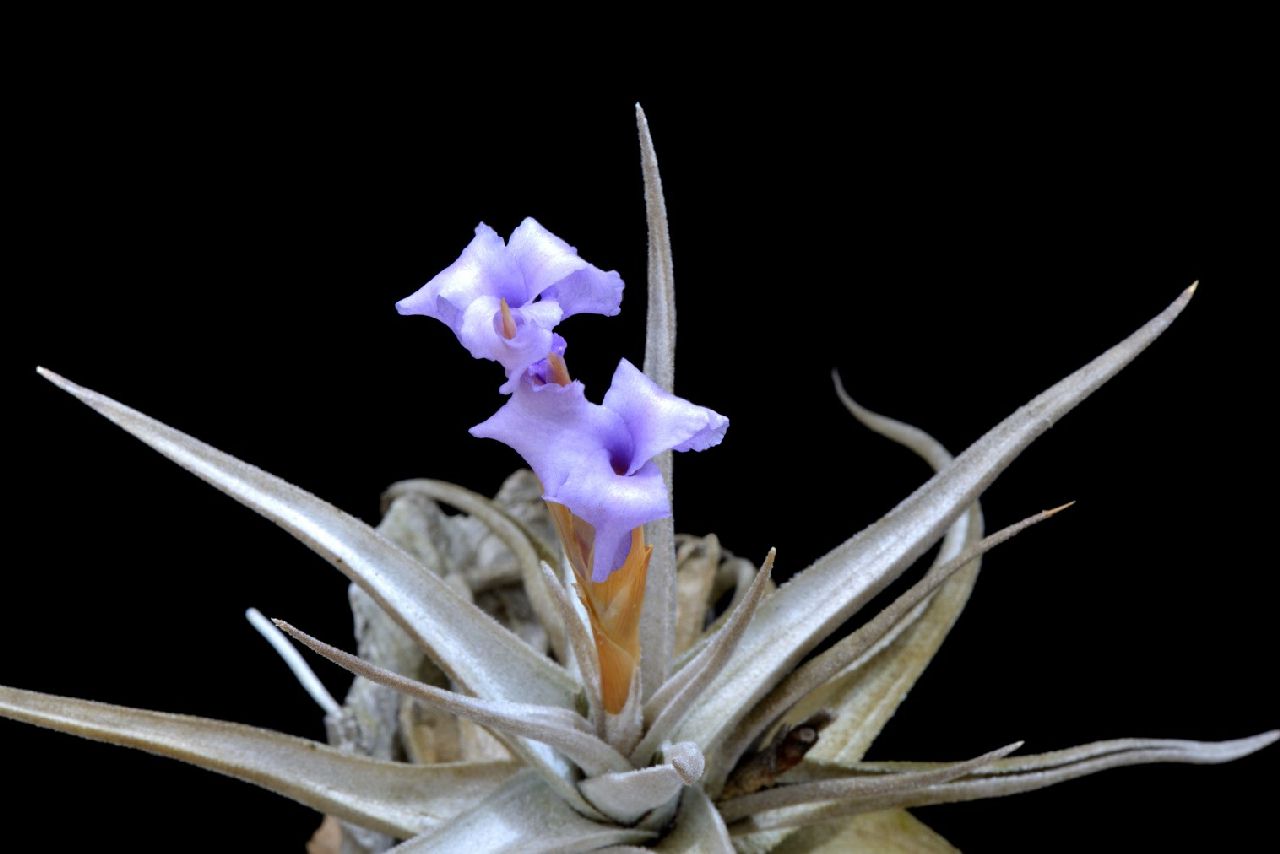
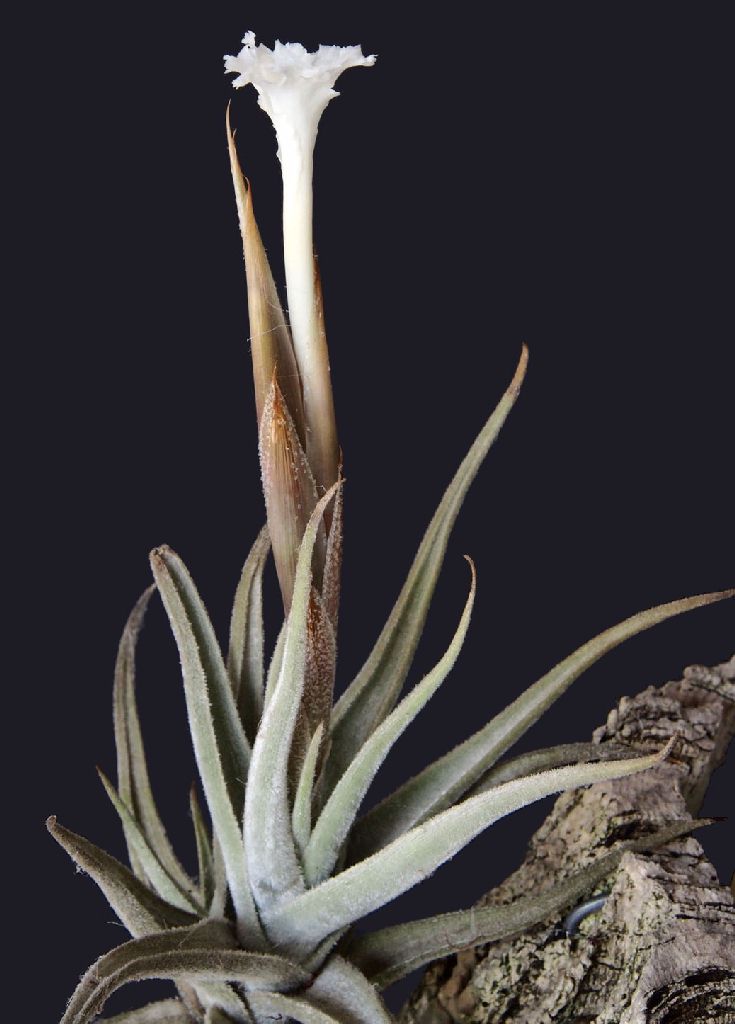
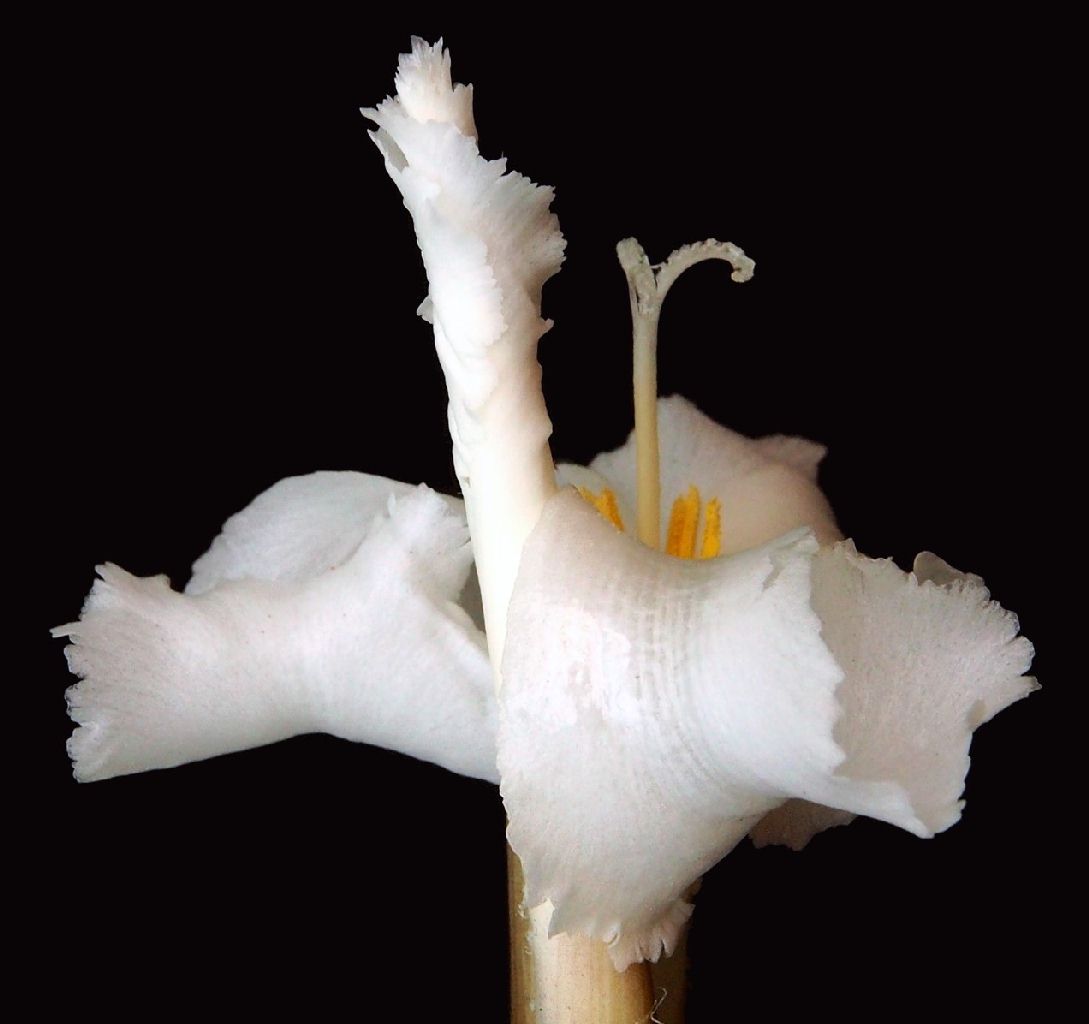
| George Nieuwenhoven 12/16 |
Julie Batty 11/17 as xiphioides |
Julie Batty ... "This particular xiphioides has only produced two flowers but they were relatively large, perfumed, and looked good with the bronze sepals."
Chris Larson ... "Justin, remember that T. xiphioides var tafiensis is now T. tafiensis. This is very close to the form of the one from the top of the Tafi Valley – where I reckon Isley collected his supposed tafiensis with white flowers – Marj & I collected a very similar form there."
Julie Batty ... "I got this one from Adam and apart from the lovely bronze bit, it is also scurfier than other plainer ones I have which are almost abrasive to the touch. Do you know if the Isley find made it to Oz?"
Chris Larson ... "So many of the mis-named T. xiphioides var. tafiensis that are here with white flowers were the Isley plants. As I understand it, they didn’t have much of the true purple flowered T. xiphioides var tafiensis – no T. tafiensis – in the USA. At least for a while it was only available from Europe. The predominant form here is still the white flowered mis-named plant.
I spent a lot of time looking for it in 96 & 98 and didn’t find it in the southern location around the town of Tafi, State of Tafi or Tafi Valley. I did manage to find it in the northern location in 98 – just dumb luck. Now with Google maps it is easy to find the State of Tafi location. But back then the locality wasn’t on the maps and we couldn’t find any locals that knew where the town of Managua (the only reference in Smith & Downs) was. I’m pretty sure that when Paul went there he had these issues and he assumed the form at the top of the Tafi Valley, which we saw, was it. This led to a lot of confusion."
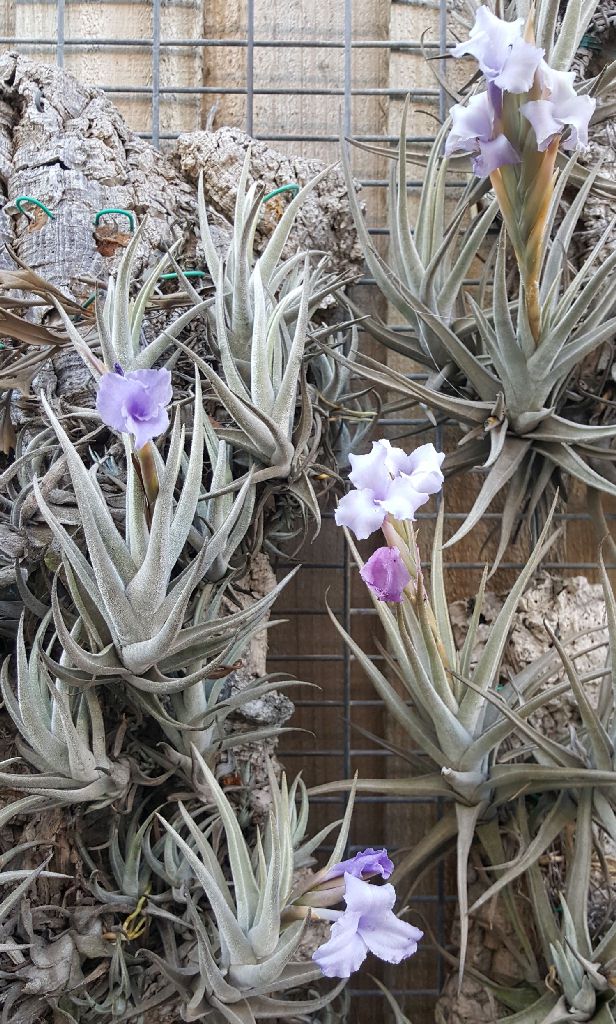
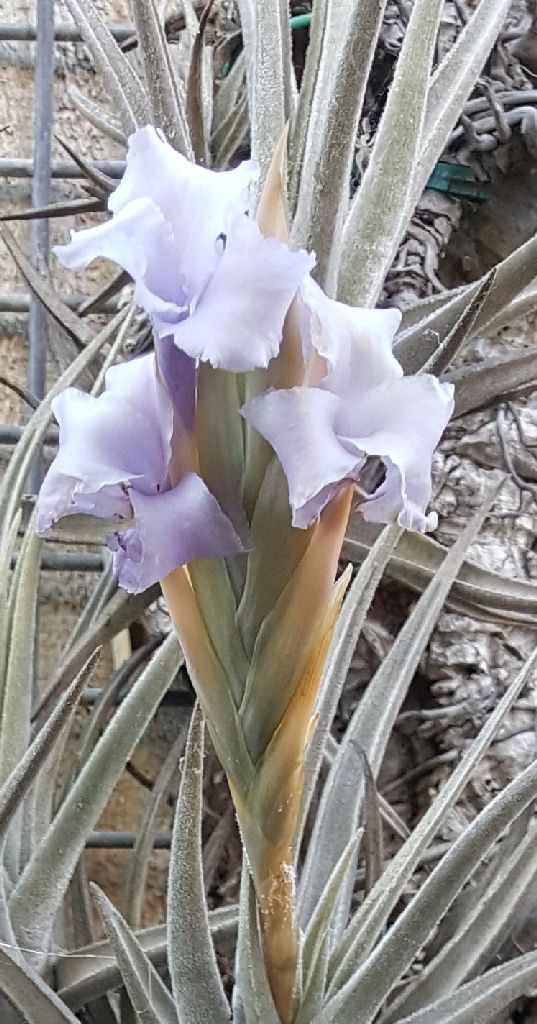
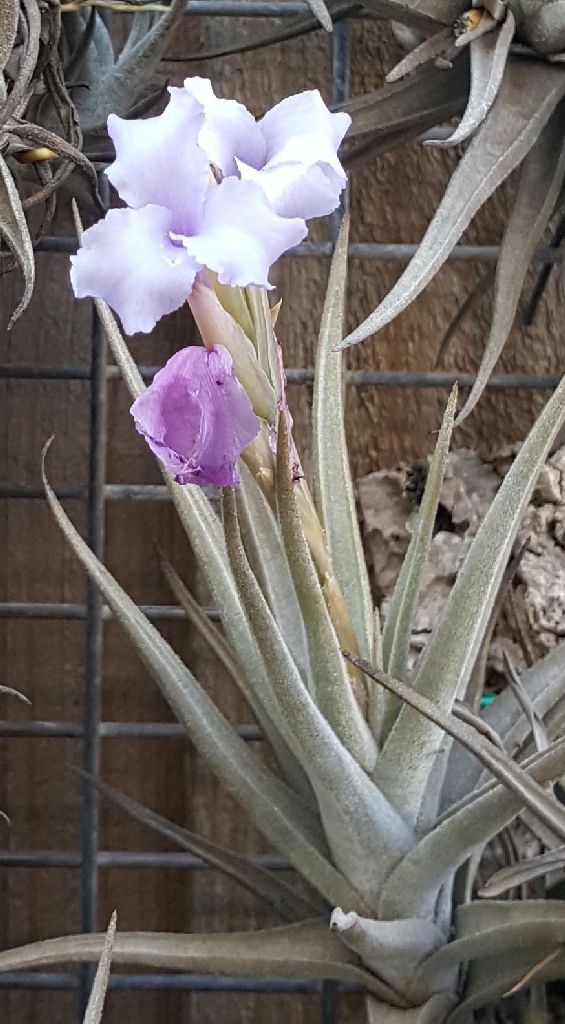 Chris Larson ... "One that will fill the house with a beautiful fragrance this year will be T. tafiensis. To think that it was 20 years ago (earlier this year) that I stumbled across this plant in a totally unexpected location in Argentina - of course in the northern locality for this sp, south of Cachi."
Chris Larson ... "One that will fill the house with a beautiful fragrance this year will be T. tafiensis. To think that it was 20 years ago (earlier this year) that I stumbled across this plant in a totally unexpected location in Argentina - of course in the northern locality for this sp, south of Cachi."
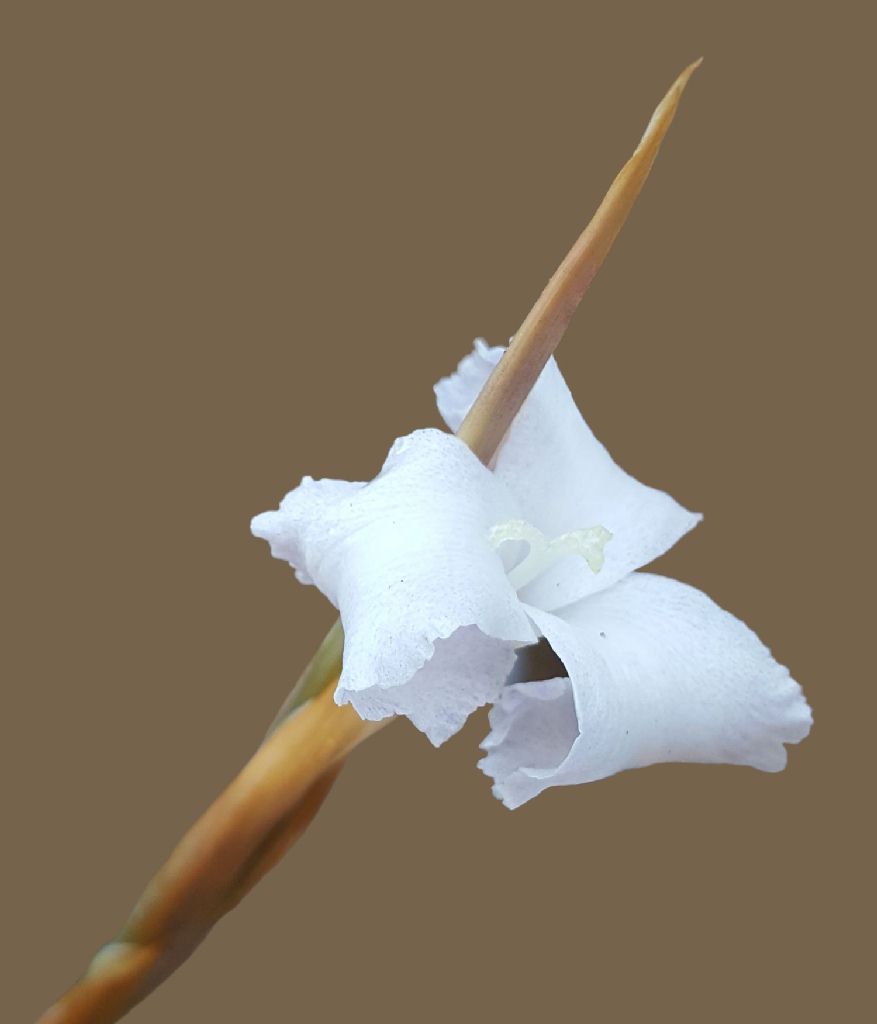
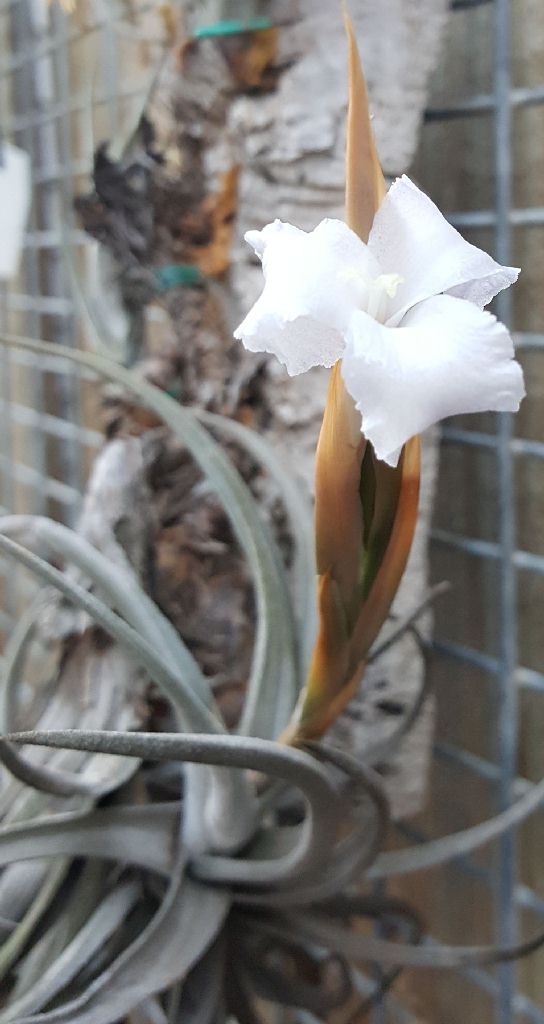
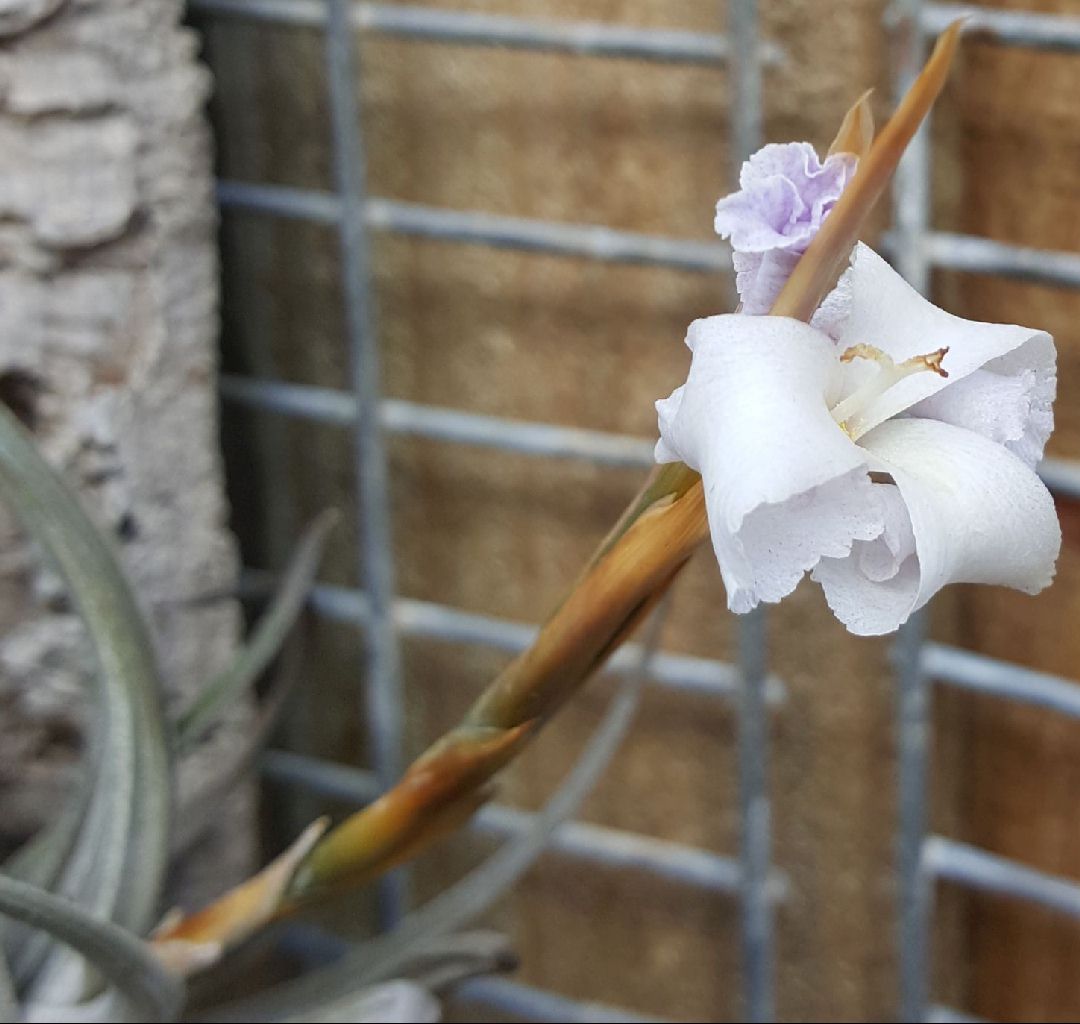 Chris Larson ... "This is a very slightly blue flowered form of T. tafiensis. Difficult to photograph. It has a very slight blue hue, with a few spots – and in the closeup photo you can see a few lines and spots if you look at the foreground left hand petal toward the left side. In person the blue in the petal is very definite. I collected it 20 years ago and have noticed the blue flowers many times – but no data on the locality.
Chris Larson ... "This is a very slightly blue flowered form of T. tafiensis. Difficult to photograph. It has a very slight blue hue, with a few spots – and in the closeup photo you can see a few lines and spots if you look at the foreground left hand petal toward the left side. In person the blue in the petal is very definite. I collected it 20 years ago and have noticed the blue flowers many times – but no data on the locality.
BTW. I was just checking the disc. It doesn’t show the other location for T. tafiensis – even though it is quoted in S & D and from my collection. I just measured the sex bits of the Cachi form – and it fits the rest of the description – though I don’t understand how silver the silver has to be to fit ‘Leaf-scales with narrow lobes, making the leaves tomentose-lepidote’. The Cachi form is not as silver as the Tafi form – or should we say the Quilmes/Managua form, because the type is not in the Tafi Valley or near the town of Tafi."
Derek Butcher ... "Protologues and document attached(below). As far as I am aware the only collections that are recorded by botanists are linked to herbarium specimens. There will always be challenges in identifying a collection or photos taken of plants found in the wild."
var. tafiensis L.B.Smith, var. nov.
A var. xiphioidesas foliis tomentoso-lepidotis, bracteis florigeris (5-6cm) sepalisque (30cm) minoribus, petalis vio;aceis differt. T. friesii sensu Castellanos, An. Mus. Hist. Nat. Buenos ires 37:501, pl. 1. 1933.
ARGENTINA: TUCUMAN: Tafi: on algarrobo (Prosopis), Managua (Colalao del Valle), 2000 m. alt, December 1931, Schreiter 7176 (US, type; LIL).
Tillandsia tafiensis (L.B. Sm.) Gouda comb. et stat. nov. J Brom Soc 65(2): 120. 2015
Basionym: Tillandsia xiphioides var. tafiensis L.B.Sm. (1970), Phytologia 20 173.
Type: Argentina: Prov. Tucuman, Tafi, Managua, Alt.2000 m.12-1931. R. Schreiter 7176 (holo US, iso GH, K, LIL, NY).
Another variety that deserves to be a species to its own right is Tillandsia xiphioides var. tafiensis L.B.Sm. (1970). It has variously purple-blue petals like several other species from the Tillandsia xiphioides complex and has a different form of indumentum (strongly asymmetric trichomes). More study is needed to compare this species with other species of the Tillandsia xiphioides complex (see also Hromadnik 1989, 1990, 1991), like Tillandsia gerdae Ehlers (1987), Tillandsia cochabambae E.Gross & Rauh (1986) and Tillandsia recurvispica L.Hrom. & P.Schneider (1987).
Tillandsia xiphioides Ker-Gawler var tafiensis L. B. Smith, Phytologia 20: 173. 1970.
Tillandsia friesii sensu Castellanos, An. Mus. Nac. Hist. Nat. Buenos Aires 37: 501, pl. 1. 1933; in part, non Mez, 1906.
Description from S&D
Differs from Type in
Leaf-scales with narrow lobes, making the leaves tomentose-lepidote.
Floral bracts 5-6 cm long.
Sepals 30 mm long;
Petals violet.
Type. Schreiter 7176 (holotype US, isotypes GH, NY, LIL), Managua (Colalao del Valle), Tafi, Tucuman, Argentina, Dec 1931.
DISTRIBUTION. Epiphytic, 2000-3000 m alt, northwestern Argentina. ARGENTINA. Tucuman, Tafi: Quebrada de Amaicha, El Molle, Nov 1932, Schreiter 8835 (GH, LIL).
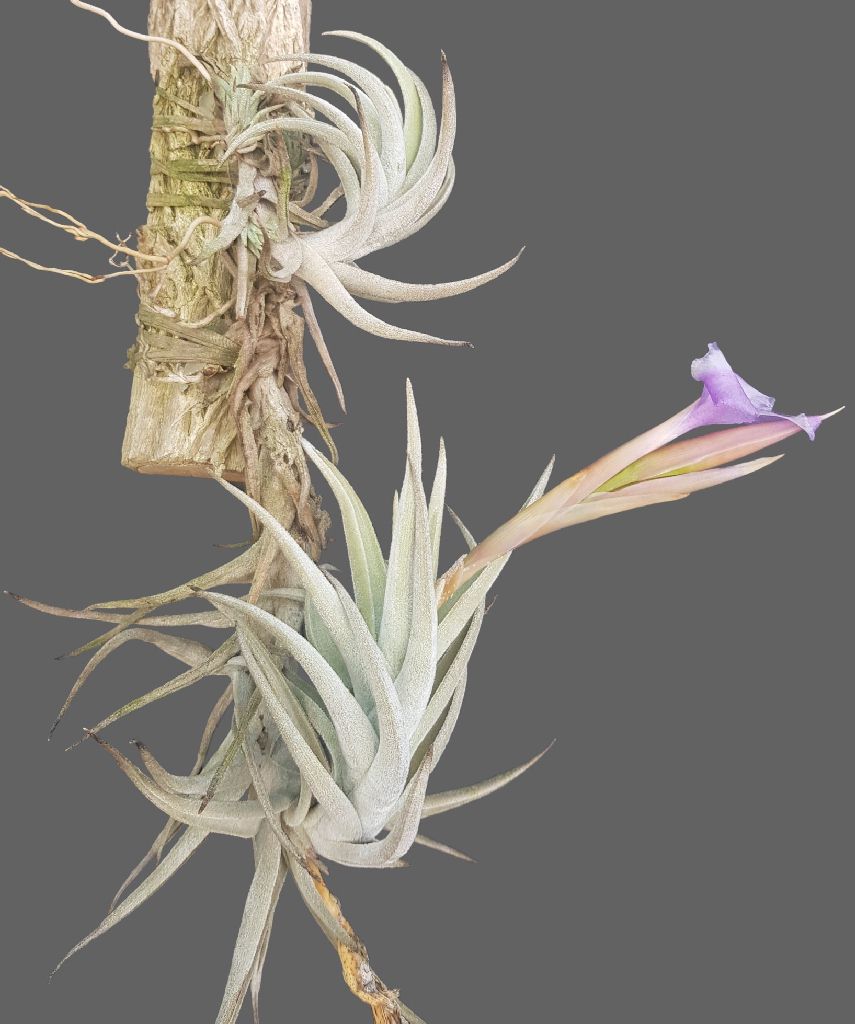
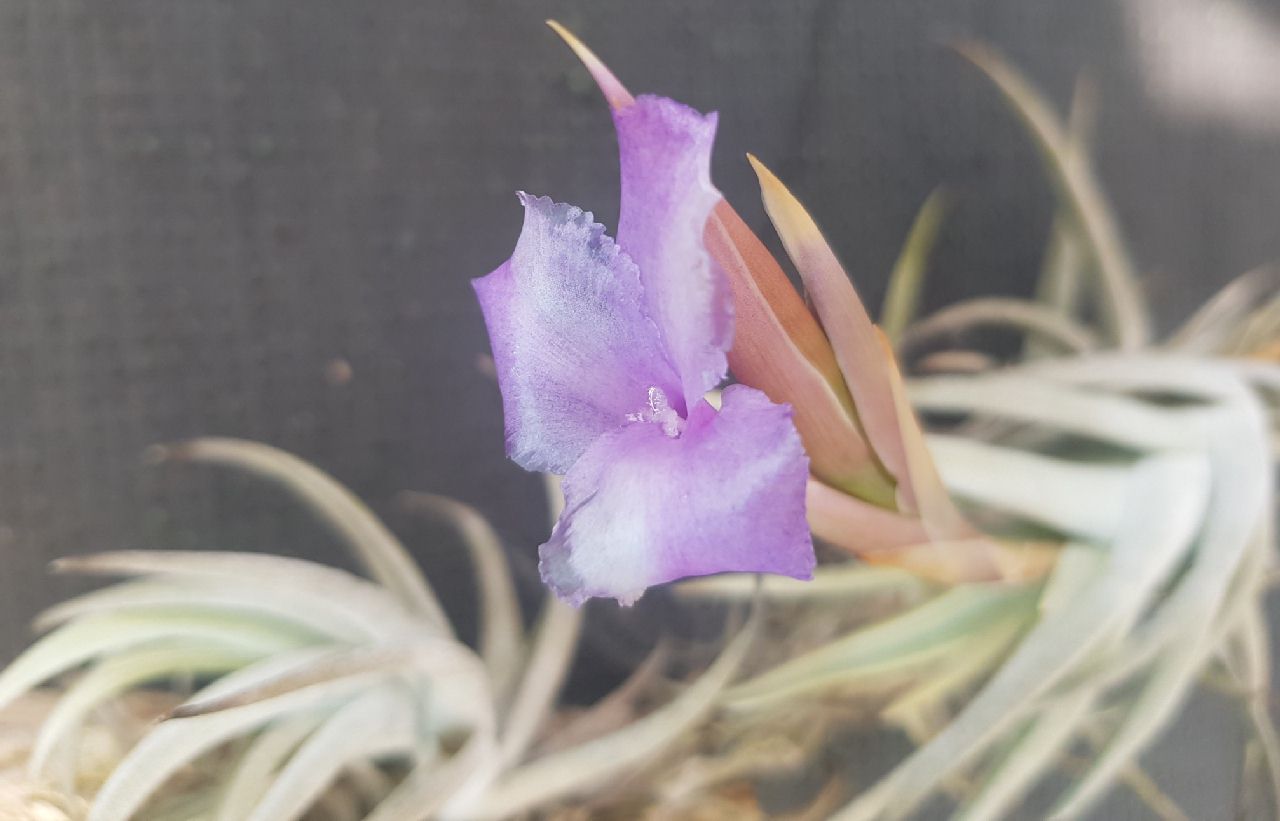

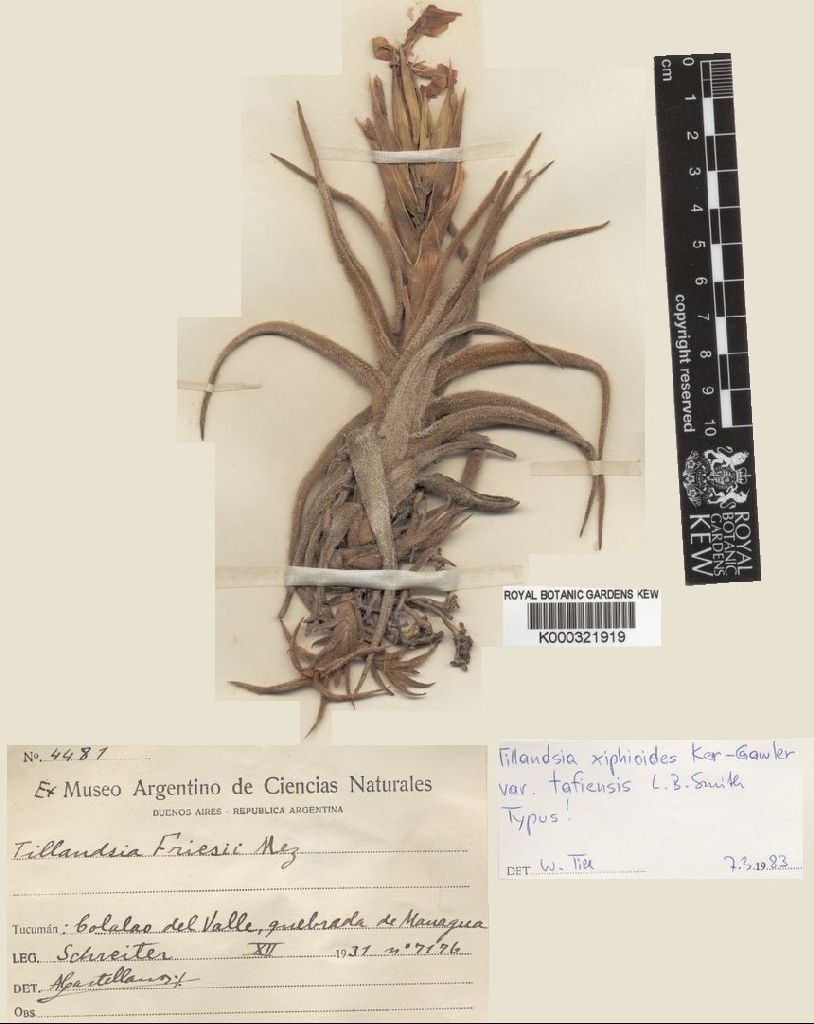
| Peter Tristram 01/20 as var. tafiensis |
Chris Larson 01/20 |
Dale Dixon 01/20 image of the type |
Peter Tristram ... "Here is one that Chris collected back in 1997-98? xiphioides var tafiensis."
Derek Butcher ... "Now treated as a species - see extract below. A pity that Chris did not get a mention."
Chris Larson 01/20 ... "I certainly do remember this one. Not in flower when I saw it, but I had an inkling that it was what I was looking for. I still remeber the excitement of seeing it come into flower in quarantine while at work. I reckon I went in about 10 times to see if the petals were really going to have colour when fully open.
Also, it is interesting that the second locality mentioned in S & D is not mentioned in the word doc. Is there any reason for this Derek & Eric? For this is where I found it, near Cachi in Argentina - quite a ways away from Managua, near the ruins of Quilmes further south."
Derek Butcher ... "A taxonomist will have to check me but only Schreiter 7176 was made the type. Schreiter 8835 from Amaicha was only mentioned as a link in S&D. If you are worried about the identity link may I suggest a cultivar name. There are sufficient copies of this clone in Australia to do this."
Species listing ... "Var. TAFIENSIS L. B. Smith, var. nov. A var. xiphioides foliis tomentoso-lepidotis, bracteis florigeris (5-6cm) sepalis-que (30cm) minoribus, petalis violaceis differt. T. friesii sensu Castellanos, An. Mus. Hist. Nat. Buenos Aires 37: 501, pl. 1. 1993.
ARGENTINA: TUCUMAN: Tafi: on algarrobo (Prosopis), Managua (Colalao del Valle), 2000m alt, December 1931, Schreiter 7176 (US, type; LIL)"
Dale Dixon ... "Just because a specimen is not mentioned in the original publication doesn’t mean that it’s a new species or that it needs a cultivar name. It could merely be an extension of range. This happens all the time. Did Chris Larson lodge a specimen with a herbarium? If not then how could a taxonomist possibly see it."
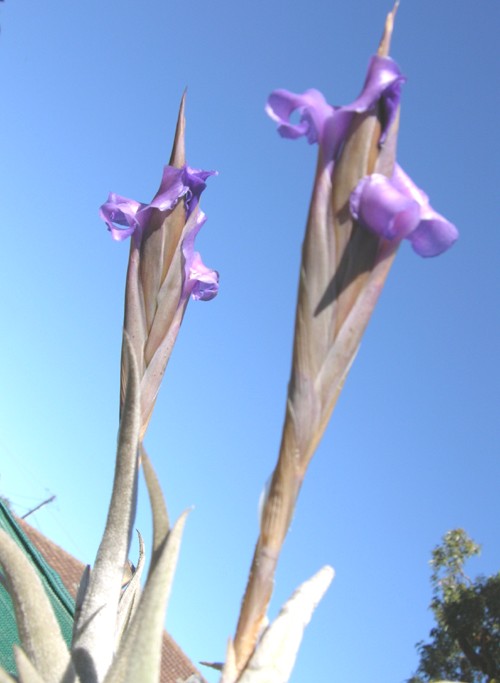
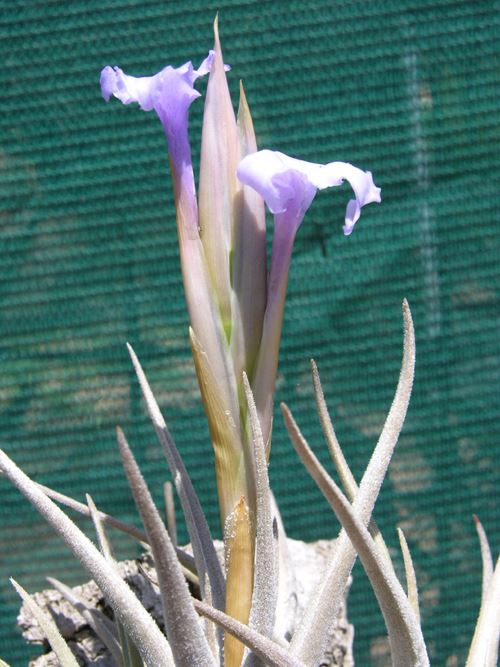
| Len Colgan var. tafiensis ex. Chris Larson from just north of Quilmes |
Len Colgan var. tafiensis ex. Chris Larson from from south of Cachi |
Tillandsia tafiensis (L.B. Sm.) Gouda comb. et stat. nov. J Brom Soc 65(2): 120. 2015
Basionym: Tillandsia xiphioides var. tafiensis L.B.Sm. (1970), Phytologia 20 173.
Type: Argentina: Prov. Tucuman, Tafi, Managua, Alt.2000 m.12-1931. R. Schreiter 7176 (holo US, iso GH, K, LIL, NY).
Another variety that deserves to be a species to its own right is Tillandsia xiphioides var. tafiensis L.B.Sm. (1970). It has variously purple-blue petals like several other species from the Tillandsia xiphioides complex and has a different form of indumentum (strongly asymmetric trichomes). More study is needed to compare this species with other species of the Tillandsia xiphioides complex (see also Hromadnik 1989, 1990, 1991), like T. gerdae Ehlers (1987), T. cochabambae E.Gross & Rauh (1986) and T. recurvispica L.Hrom. & P.Schneider (1987).
Tillandsia xiphioides Ker-Gawler var tafiensis L. B. Smith, Phytologia 20: 173. 1970.
Tillandsia friesii sensu Castellanos, An. Mus. Nac. Hist. Nat. Buenos Aires 37: 501, pl. 1. 1933; in part, non Mez, 1906.
Description from S&D
Differs from Type in:
Leaf-scales with narrow lobes, making the leaves tomentose-lepidote.
Floral bracts 5-6 cm long.
Sepals 30 mm long;
Petals violet.
Type. Schreiter 7176 (holotype US, isotypes GH, NY, LIL), Managua (Colalao del Valle), Tafi, Tucuman, Argentina, Dec 1931.
DISTRIBUTION. Epiphytic, 2000-3000 m alt, northwestern Argentina. ARGENTINA. Tucuman, Tafi: Quebrada de Amaicha, El Molle, Nov 1932, Schreiter 8835 (GH, LIL)
Chris Larson 07/20 ... "Hi Derek. This query has been hanging around from January awaiting time to do referencing, it has been sitting in my drafts in Outlook for quite a while until I have had time to look at it. I was thinking in the earlier email that S & D was the reference for me to look at Cachi as a possible location of this sp, on my second trip to the region. However, on reflection I sort of remember something in the BSI Journals. Today I searched the disc, and have rewritten the draft.
From your comments, below, I am unsure of whether you intend that the type represents the whole of the species.
There is a reference to T. tafiensis in the article by Lotte in 1989 on the disc:
{T. xiphioides var. tafiensis grows near Tafi Del Valle at a, for T. xiphioides an extreme height up to 3000m.
A second place of discovery is near Payogasta, Cachipampa, Prov. Salta, Hr 7135, it lies approximately 200 km further North and likewise near 2700 m high. Also here, the plants grow conclusively on rocks, in association with Deuterocohnia aff. meziana and Parodia aureicentra. In the winter months at such height the temperature falls at night to -10°C and on cloudy days hardly climbs a few degrees above zero.}
(I remember collecting plants around Payogasta, which included an interesting plant with pink flowers (this was another 1/2 to an hour north of Payogasta) – I remember we discussed this plant and you suggested that it was close to friesii – but not quite. And friesii grows in the next major valley, or two, over to the north – a long way around by car – but not as the seed flies. But I did not find T. tafiensis here unless it was not in flower & died in quarantine.
Payogasta, from where Lotte says another form of T. tafiensis grows, is only a short drive north of Cachi. My plant was found just a short drive south of Cachi. This was the basis of my search for this plant in this region – though I am quite sure that it was not this particular article (quoted above) that I was acting on, but a similar one in a BSI Journal which quoted the Cachi locality.
Is this enough of a reference to say that T. tafiensis is not just localised to the area just north of the ruins of Quilmes – near the town of Managua?
BTW. Your reference to Amaicha is not what I see in S & D, but rather the Quebrada (Valley) de Amaicha. Marj & I hiked across to the hills on either side of the road at the correct altitude around the town Amaicha. Here there was a plant that we speculated was the plant Paul Isley was selling as T. xiphioides var tafiensis – but this one had white flowers like Pauls plant, so we knew we were not finding the holy grail of what was then T. xiphioides var tafiensis.
Quebrada de Amaicha is a good distance away from the Managua site of the type mentioned in S & D. I noticed Managua is near Cololao Del Valle last time when it appeared in Google. Today my Google maps is not showing the town of Managua, which I have found before in my searches. So I couldn't confirm it today.
S & D's reference to the Quebrada De Amaicha as the distribution, and to a location near Cololao Del Valle as the type locality, is one of the reasons so many did not find it. How can the type location be found outside of the distribution - and in this I am assuming the Quebrada de Amaicha is around the Amaicha River as Google is telling me?
Sorry, but I spent over 2 full days searching on my trips in this area for this one species. Frustrating but fun."
Derek Butcher ... "The main problem is that you did not do a herbarium specimen of your collection which means you get ignored by Taxonomists. I still think you are correct in identifying your collection as T. xiphioides and no doubt others who got an offset from you have ex-Larson on the label. I assume you do not intend in lodging a herbarium specimen in Argentina somewhere. You can still give your collection a cultivar name and register it in the BCR so that the full story would be known."
Brenton Cadd ... "Derek, not being knowledgeable about these things, and for my own interest. Can Chris call it aff tafiensis and have it registered on BCR?"
Updated 04/12/20


















